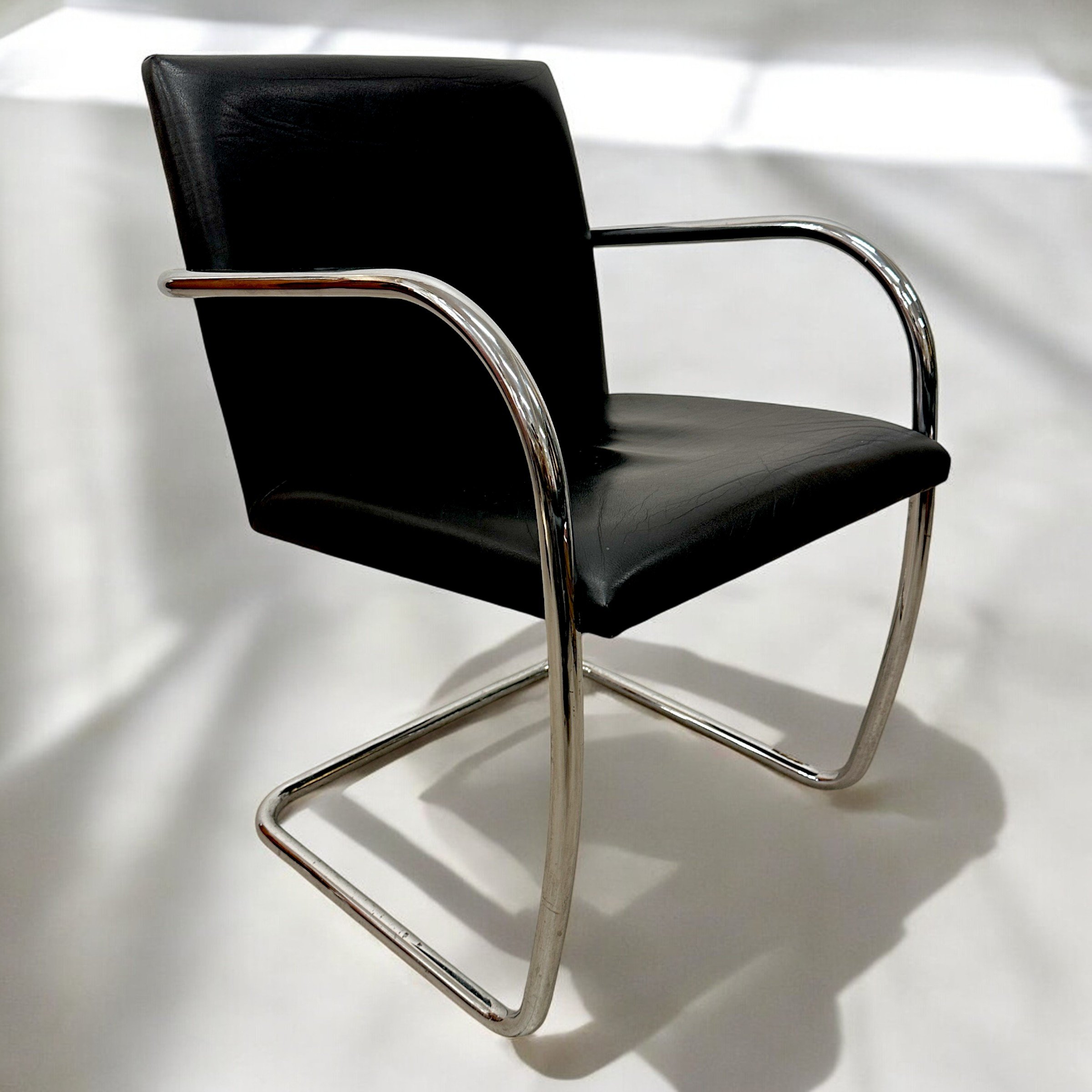1980s BRNO CHAIR DESIGNED BY MIES VAN DER ROHE (TWO AVAILABLE)
The Brno Tubular Chair, designed by Ludwig Mies van der Rohe, is a hallmark of modern furniture design, originating from the Bauhaus movement. Created for the Tugendhat House in Brno, Czech Republic, the chair features a sleek tubular frame made from chrome-plated or stainless steel, which provides both durability and aesthetic appeal. Its minimalist design is characterized by a seamless connection between the seat and frame, enhancing its clean lines. The seat and back are crafted from hardwood and multi-density polyurethane foam, ensuring comfort while maintaining a sophisticated look.
These particular examples are genuine Knoll International pieces dated from the 1980s. Whilst Knoll was yet to brand their pieces, the feature the ‘Artes Studio’ label (now Space Furniture) indicating these were imported directed from the manufacturer.
In excellent vintage condition, the chrome has only light patina and the leather is supple and generally mark free.
Price per chair and available to view at our Alexandria Studio.
Dimensions: 55cm W x 63 cm D x 79 cm H
The Brno Tubular Chair, designed by Ludwig Mies van der Rohe, is a hallmark of modern furniture design, originating from the Bauhaus movement. Created for the Tugendhat House in Brno, Czech Republic, the chair features a sleek tubular frame made from chrome-plated or stainless steel, which provides both durability and aesthetic appeal. Its minimalist design is characterized by a seamless connection between the seat and frame, enhancing its clean lines. The seat and back are crafted from hardwood and multi-density polyurethane foam, ensuring comfort while maintaining a sophisticated look.
These particular examples are genuine Knoll International pieces dated from the 1980s. Whilst Knoll was yet to brand their pieces, the feature the ‘Artes Studio’ label (now Space Furniture) indicating these were imported directed from the manufacturer.
In excellent vintage condition, the chrome has only light patina and the leather is supple and generally mark free.
Price per chair and available to view at our Alexandria Studio.
Dimensions: 55cm W x 63 cm D x 79 cm H
The Brno Tubular Chair, designed by Ludwig Mies van der Rohe, is a hallmark of modern furniture design, originating from the Bauhaus movement. Created for the Tugendhat House in Brno, Czech Republic, the chair features a sleek tubular frame made from chrome-plated or stainless steel, which provides both durability and aesthetic appeal. Its minimalist design is characterized by a seamless connection between the seat and frame, enhancing its clean lines. The seat and back are crafted from hardwood and multi-density polyurethane foam, ensuring comfort while maintaining a sophisticated look.
These particular examples are genuine Knoll International pieces dated from the 1980s. Whilst Knoll was yet to brand their pieces, the feature the ‘Artes Studio’ label (now Space Furniture) indicating these were imported directed from the manufacturer.
In excellent vintage condition, the chrome has only light patina and the leather is supple and generally mark free.
Price per chair and available to view at our Alexandria Studio.
Dimensions: 55cm W x 63 cm D x 79 cm H
ABOUT THE DESIGNER
Ludwig Mies van der Rohe's architectural career began in Berlin in the early 20th century. After working with Bruno Paul and Peter Behrens, he established his own practice in 1912. His early work, including the Riehl House (1907) and designs for the Kröller-Müller House (1912-1913), showed hints of the modernist principles that would define his later career. However, it was the German Pavilion for the 1929 Barcelona International Exposition that catapulted Mies to international fame. This groundbreaking structure, with its open plan, minimal structure, and innovative use of materials, embodied his emerging philosophy of "less is more."
In the 1930s, Mies's career took a significant turn when he became the last director of the influential Bauhaus school. Although the school was forced to close in 1933 due to pressure from the Nazi regime, Mies's tenure there solidified his reputation as a leading figure in modernist architecture and design. His work during this period, including the Tugendhat House in Brno (1930) and his designs for the Reichsbank competition (1933), further developed his minimalist aesthetic and structural clarity.
Mies's career entered a new phase when he emigrated to the United States in 1937. He was appointed head of the architecture department at the Illinois Institute of Technology (IIT), where he redesigned the campus, creating a cohesive modernist environment. The Crown Hall (1956) at IIT is considered one of his masterpieces from this period. Simultaneously, Mies began working on private commissions, producing iconic works such as the Farnsworth House (1951) in Plano, Illinois, which pushed the boundaries of residential architecture with its transparent glass structure.
The latter part of Mies's career was marked by large-scale projects that defined the International Style in architecture. The Seagram Building in New York City (1958) became the prototype for corporate architecture in America. Other notable late works include the Toronto-Dominion Centre (1967-1969) and the New National Gallery in Berlin (1968). These projects showcased Mies's mature style, characterized by the use of industrial materials, particularly steel and glass, to create buildings of elegant simplicity and structural expression. Until his death in 1969, Mies continued to refine his architectural philosophy, leaving an indelible mark on 20th-century architecture and influencing generations of architects to come.











































